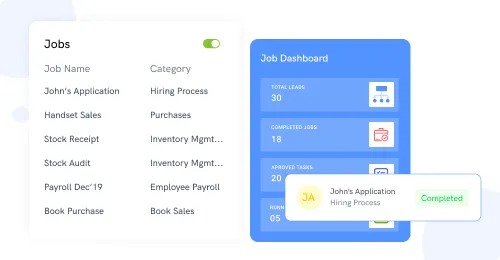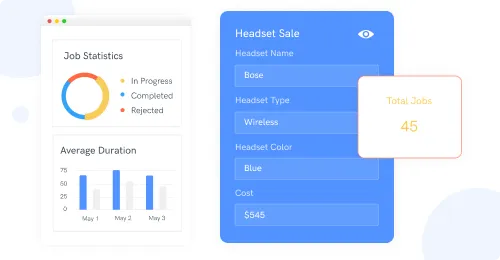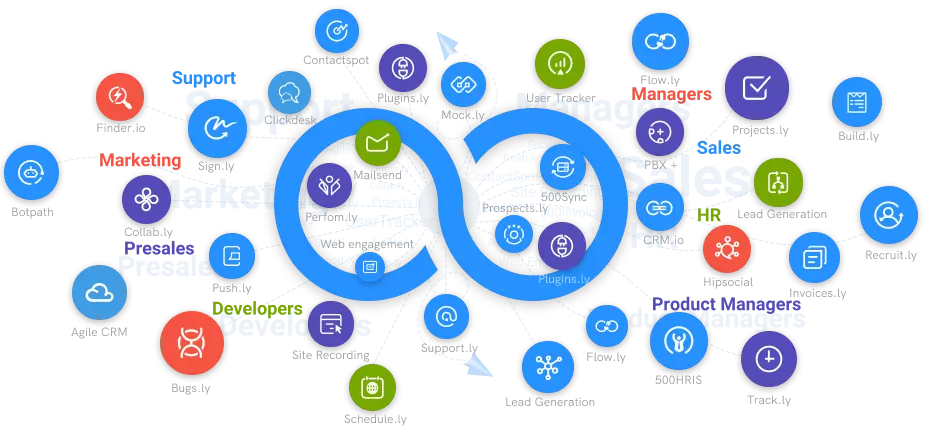Benefits of Business Process Management
Identifying, automating, and optimising tasks has numerous advantages and benefits when combined with BPM solutions.
#1
Unlimited Process Automation
#2
No-code Process Modelling
#3
Notifications and Triggers
#4
Auto Execute Capability
#5
Integrate with over 8 Apps Including Gmail
#6
Effective Form Designer
#7
Pre-built Automated Flows
#8
Intuitive, Drag-and-Drop Process Designer
#9
Unbelievable pricing - the lowest you will ever find
#10
Everything your business needs - 50 apps, 24/5 support and 99.95% uptime
Business Process Management (BPM) – Identification, Automation, and Optimization of Tasks - comes with immense benefits. And with BPM solutions such as BPMApp, businesses can now optimize business processes, as well as efficiently implement changes that have been recommended.
A business is made up of repetitive processes and/or tasks that are geared towards achieving organizational goals. Business process management is the blueprint through which these repetitive tasks are not only automated but also accomplished most efficiently. BPM works by breaking down business processes into a series of distinct, repeatable tasks and provides an analytical representation of how these processes are interconnected.
This is the best practice as according to CIO, “Many companies develop business processes in isolation from other processes they interact with, or worse, they don't "develop" business processes at all. In many cases, processes simply come into existence as "the way things have always been done," or because software systems dictate them. As a result, many companies are hampered by their processes, and will continue to be so until those processes are optimized.”
The business processes that can be improved using BPM tools include account management, employee recruitment, loan origination, leave requests, invoice management, compliance management, project management as well as customer requests and service orders.

The ultimate goal of BPM is to make an organization more efficient and effective while optimizing its most important processes. It is no wonder then that more and more businesses have come to appreciate the importance of this practice. According to Yahoo!Finance reporting on Business Process Management Market Research, the BPM market is expected to grow to approximately USD 16 billion by 2023, with a 14 percent CAGR between 2017 and 2023.
So, what is it about BPM that makes it all the rage? CIO argues that "As organizations barrel into the digital era, the primary driver of BPM’s new digital transformation role is the demand for organizational agility.” Organizational agility is crucial as the business ecosystem is in a constant state of change. It is thus important for business processes to quickly adapt to these changes. Indeed, it is survival for the fittest. Besides organizational agility, businesses that use BPM enjoy the following benefits.
1. Cost Reduction: For a company to remain functional and steady, it needs to focus on reducing the cost of business processes especially in volatile economic times such as this. One of the reasons why businesses employ the use of BPM is to save money. This starts with identifying and defining business processes which are then mapped in detail. These process maps reveal the resources needed, the duration of the tasks, and the budgetary implications. They help the company identify redundant processes, highlight excessive materials, define the cost and quality control issues. Redundant processes that the company has no time for being eliminated or outsourced to save cost.
2. Improves Business Agility: The business playing field is changing, forcing organizations to change with it. An organization can create flexible and customizable processes and alter these processes at a minimal cost. An organization may be forced to change due to emerging competition, new business regulations, technological advancements, and market demands, hence requiring a quick response to remain competitive. A well-integrated BPM using a solution such as BPMApp will help a company recognize a problem, halt its operations, and revive within the shortest time.
These flexible processes can evolve and have trackable changes which can be refined to suit the changing needs of the company. Changes are recorded and the managers can use these reports to predict the effects of these changes on the overall business process. Automation of business processes eliminates the need to hire or maintain staff needed for the previously repetitive and tedious tasks. Maintaining a lean team helps the organization to save costs.
3. Increased Productivity:
Rising competition is forcing companies to focus on productivity to remain relevant and profitable. BPM facilitates the improvement of business processes such as automation of repetitive tasks, removing bottlenecks, boosting parallel processing, and elimination of redundant tasks. Employees are therefore left with lots of time to focus on other business tasks therefore boosting productivity across all departments. A good example of a company that used BPM to boost productivity is Adidas. Adidas realized the need to boost productivity to fill up their orders faster and effectively, and reduce lag time. By adopting a BPM, they were able to reduce the lag time from order placement to delivery of those orders.
4. Increased Efficiency and Reduced Errors: Inefficient processes waste time and resources and lead to bottlenecks in the workflow. BPM pinpoints these inefficiencies earlier on in the business process and avoids these bottlenecks and redundancies. BPM can predict how a process will operate under optimal conditions and give users a chance to make alterations. Errors are impossible to track when using primitive tools like spreadsheets. The likelihood of errors occurring is high when there are no stakeholders in the flow of business processes. Automation of business processes increases efficiency by cutting down on human error and including stakeholders in each step of the process. These stakeholders are well informed of their duties and have to meet their obligations. In case of errors occurring, they can be traced to an earlier source.
5. Recognizing and Responding to New Customers: Business process management is becoming more customer-centric and less focused on productivity. Business managers need to focus on customers to recognize diversifying trends, demands, and preferences. To succeed, a business needs to focus on its customers and be aware of their changing demands and preferences. Optimizing business processes should be centered on meeting customer demands rather than selling out products which will in turn improve metrics such as customer satisfaction and retention.
Customer-centric BPMs improve productivity by meeting customers' needs, encourages solution-based approaches, encourages innovation, and re-engineers processes to be more flexible and focused on customer experience. Having leaner processes leaves time for employees to build solutions and to focus on tasks that will elevate customer experience and be beneficial to stakeholders.
6. Compliance and Security: Businesses have to operate within a set of rules and regulations failure to which they might run into unnecessary complications and incur hefty fines. Companies using BPM can implement these regulations and create work plans that are not only compliant but can change with a shift in regulations and guard against fraud. Process mapping in each phase of a business process ensures proper documentation of workflows, which can be used as a framework to design more security.

BPM has an organizational structure that emphasizes the importance of information, asset, and data privacy, to safeguard it from theft or loss. One feature of BPM is role-based access control aimed at protecting data. Data protection is very important to any corporation. It is, therefore, important that a firm creates access controls for different levels of users to protect sensitive data. Access control metrics involve making documents read-only, hide them completely, or make specific fields editable. Adopting a BPM is a sure way of ensuring you integrate compliance into the business processes.
7. Encourages Transparency and Visibility: Processes are mapped with detailed workflows and proper documentation for each phase of the business process, therefore, giving visual accountability and transparency. BPM Software can register, track, and monitor individual automated business processes from beginning to completion as each step is gauged for effectiveness in real-time. This automated monitoring ensures visibility throughout business processes and reveals their performance with no need for intensive manual involvement.
Visibility allows a company to focus on its inefficiencies, learn their mistakes and work towards designing, executing, and monitoring better processes to reduce risks such fraud, theft loss of data, and a drop in customers. Clear visibility of business process performance in real-time will help managers gain a better understanding of the overall business activity, enabling them to either adapt to the workflow or modify it for optimal performance. It will further enable management to respond quickly to changes in projects and emerging opportunities.
8. Easy Customer Retention: One of the key reasons why customers drop a product or service is poor customer experience. Customer retention is a metric with a higher ROI than recruiting new ones, costs much less, and has the potential of earning the business more profits over time. An integrated BPM helps to tie customer service, support, and success into all company activities, in working towards a better customer experience.
Customer satisfaction can also be achieved by optimizing metrics such as productivity and innovation which will improve customer retention. BPM creates a process for everything and records data from each process, enabling the team members to identify new opportunities and gauge each other's performance and knowledge from customer interactions.
9. Driving a Competitive Advantage: A company needs to keep up with competitors to remain relevant in the market. When business processes are always operational, repetitive, and inefficient, waste and redundancies will accumulate. This leaves no time to focus on innovation, R&D (research and development), and other activities to stay above your competitors. Automation of business processes through BPM makes them reliable and efficient, leaving lots of time and resources to focus on activities that will grow and develop the business.
10. Providing a Company-wide Platform: Department-specific software is customized for unique usage and accessing data across departments can be very difficult. BPM is integrated to act as a central platform for the company, where data can be fetched and pushed to core pre-installed software systems such as ERP and CRM. Automating processes reduces manual entries and cuts down on cycles. All a company needs to do is create accounts for their employees in the BPM system so that they can access its core operations and data, but bearing in mind access controls.
11. Transfer of Business Knowledge: A company’s workforce may shift as employees transfer to other branches, leave for employment to other companies, or just retire. The shifting workforce takes the knowledge they have gained with them. This leaves the company with a knowledge gap and elicits a need to transfer this knowledge to successive employees, to avoid disruption. BPM ensures proper documentation and detailing of process maps for individual workflows. This documentation is archived and used in the orientation and training of new employees to reduce the disruption caused by changes in workflow.
12. Measurability: BPM encourages measuring of processes end to end and comparing these processes to expected results. Processes can be streamlined and quantified to observe how they are aiding the organization in optimizing its workflow. Integrating BPM with technology provides tools for analysis and reporting which helps to manage people and decisions and helps in making executive decisions.
13. Technology Integration: BPM has facilitated bridging the gap between IT and business users by the use of business process model and notation (BPMN). BPM can be easily integrated into pre-existing software such as BAM and can import documents from other software.
Yahoo!Finance echoes similar sentiments arguing that the major factors behind the rise and rise of BPMs include the “integration of Artificial Intelligence (AI) and Machine Learning (ML) technologies with BPM software, the need for automated business processes to reduce manual errors, and improved IT systems to meet the dynamic requirements of customers.”
Conclusion:
It is no longer business as usual as companies either have to shape up to the dynamic and volatile business environment or ship out. BPM is the way to go if these companies are to optimize processes, keep up with regulatory compliance, increase productivity, cut down costs, and enhance the customer experience among other benefits that come with a well-built BPM system such as BPMApp.





